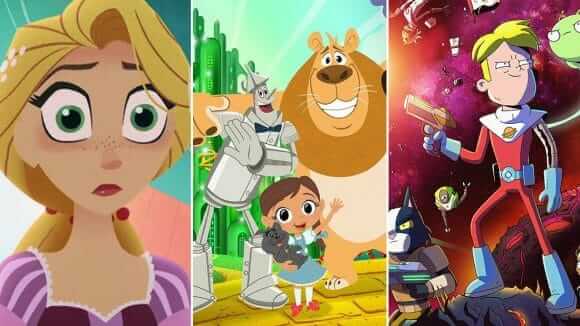
What is Animation Vocalization?
Animation vocalization is the articulation of events of animals, plants, inanimate beings and it is an art in its own right. The animation sound does not only depend on sound capability. This work is done by the person who will perform the work and the actors forget that this is a voice actor. On the other hand, the animation can be up to the number of characters in the voice of a film. This shows that this process is not very easy. The ability to improvise with imagination as well as the technical knowledge and memorization ability of the person to do this is important for a successful voice-over. Animation voice actors, as we are familiar with the master artists, but you do not hear the name of the sound, but you may also like people very liked. The real thing is that the sound is integrated into the role and something fun comes out. In order to be able to animate animation, there is a need for both personal skills and technical equipment.
There is a need for a studio environment to make vocalization. The character you use and the words you use will be available in writing. Between the studio and the figure to be spoken, a screen, a microphone, and headphones are used to help us more regularly. We hear the sound of what we’re doing by listening through this headset, adjusting the finish tones and following the script and voice. The trick is to provide a comfortable dubbing without pinching the abdominal muscles called the diaphragm.
The film can be native or foreign, so it can be done by looking at the translation of a foreign animated voiceover film. In the script, the words cried, delighted, and the sound level and shape of your choice are determined by your choices. Sounds are not thought to be exactly the same, so the same sound and gestures to capture the nearest sound level are made by trying to remove the correct sound. On the one hand, you can follow these figures on the screen, while on the other hand, you control your own voice by the sound of the headphones. A little improvisation is a difference between languages. Because language is influenced by the environment and the structure of societies. The same words can be interpreted differently for these reasons.
Animation what should be the person to speak?
Above Animation voice we have stated that the job is not a simple job, it passes through many stages. Ability is also important but alone is not enough. As in every job, the key to success in this business is to love and embrace this work. If possible, knowing a few languages will not be bad. This knowledge will help a lot in interpreting the emotions from the foreign language and interpreting the emotions. Because the animation is more appealing to children, it is important for the speakers to reflect the emotions of being a cheerful, loving and loving adventure.
Since Pixar Animation Studios released “Toy Story” in 1995, the first entirely computer-generated animated feature, animation movies have taken the world by storm. Apart from being highly innovative with incredible images, “Toy Story” had a good storyline, great dialogue, and fantastic voice acting which conveyed the unique personality of each character to perfection. Proof that one of the key factors in all animations lies in the dubbing and voice acting, which can essentially make or break the success of the film. As such, it’s not surprising that many of these animated movies feature the voices of leading Hollywood actors who earn big to depict the main characters.
It’s hard to believe that Old Kentucky Home, a short animation film released in 1926, was the first film to have synchronized sound with animated dialogue – that’s almost ninety years ago! Since then, many animation movies have made it to our international screens with content targeted at children having pioneered the popularity of dubbed animations for the most part. This company Haymillian works with a number of clients in translating and dubbing media content, and of late, we’ve witnessed a growing rise in the number of animated programs that we are being asked to dub. The traditional animation genres combined with children’s edutainment have brought even more dubbed content to our TV screens.
Children’s Edutainment & the Rise of Animation Dubbing
The long-running children’s TV series, Sesame Street, was the first preschool educational television programme to base its contents and production values on laboratory and formative research; it first hit our TV screens in 1969. Over the years, and especially in the last decade or so, the rise of children’s edutainment programmes, such as VIPO the Flying Dog, Dora the Explorer, Barney, and Friends has given an additional boost to the international dubbing industry. Moreover, we have seen an increase in the availability of foreign animations dubbed into English across high profile networks.
Some countries like France, Germany, and Italy almost exclusively dub and have a thriving dubbing industry where the viewers prefer to watch Hollywood content dubbed in their own language. It is not that they don’t particularly understand English, but they enjoy it more in their native language. They even have their own dedicated voice actors who are the only voices that represent Hollywood stars such as Sean Connery, Bruce Willis or Cameron Diaz.
Independent of this preference, most countries require that any content addressed to viewers up to 12 years old be dubbed, or to at least present a choice of dubbed and subtitled content to choose from. For this audience, in particular, subtitling doesn’t work unless an adult is beside the child to explain to them what’s happening. In this case, dubbing is a logical solution that allows children to fully enjoy their film, independently.
A Standard Dubbing Process for Animation
Dubbed content gives audiences access to some of the best media from around the world in a language they understand while offering more variety. However, dubbing is a difficult job and comes with many challenges. For the dubbing translator, the timing of sentence length and the number of syllables used is of paramount importance so that the dialogue matches the on-screen lip movements. However, no two languages are the same and where one syllable is used in English; its translation into French may require two or three syllables. This is where the dubbing translator needs to be skilled and creative without losing the message or storyline of the original creation.
In animation dubbing, it can be extremely tricky to find the right voice actor that will animate each character, convey its personality and create the illusion that the character is indeed talking! Essentially, what is done is recreating all aspects of the original version of the film into a foreign language.
Translation – The first step of any foreign dubbing process lies in the translation. During this stage, the translators work on the text and the message to create the foreign version. This is more of an art than merely a direct translation process. It can be compared with translating a book.
Adaptation – Once the translation finished, the director and his team of translators start adapting the material for recording. This may include matching the labials to editing for optimum text length.
Casting – Most of the time the casting of the actors is carried out in parallel to the adaptation process. Depending on the budget, the dubbing studio may test actors from its own database or perform a larger casting and tests. If your animation has a celebrity voice with an approved voice talent in your target territory, then your studio will have to commission their services separately.
Directing and recording – When the adaptation and the casting are approved, here is when really the fun begins! Actors recreating their character under the guidance of the director and recording of the lines. This is a very laborious and difficult process, as apart from acting, they must be familiar with lip-syncing techniques. Depending on the country this can be rhythm band, sound sections, beeps, etc.
Mixing – This is the final step of the dubbing process. Depending on the requirements of the client, the studio may need to do full video, M&E and audio mix, including graphics edition or M&E and audio mix. This is where the skills of the sound engineers working on the project are put to test.
Once we are completely satisfied with the outcome, the foreign adaptation is delivered to our client.
Worldwide releases are now a reality for major Hollywood productions and popular series where anyone, in any country, can view the same content, at the same time. Global release cycles, create the need to localize content to reach a global audience within extremely tight launch windows. These short time frames within which original content can be localized pre-worldwide launch brings huge technical and creative challenges.
Animation is easy to get into but difficult to master. There are as many styles of animation as there are animators, and starting with a short film is a great way to practice animation techniques as you develop your “autograph” style. Just like any other film, animation takes time, patience, and a lot of planning to get right, but anyone with a computer can make an animated short film
- Write out a script. This is often easier said than done, but you need to write down your ideas clearly and give them structure before you start working. Unlike in live-action, it is almost impossible to “improvise” an animated film, as it simply takes too long to animate everything.
- A theme. What is the “point” of the short film? This doesn’t need to be grand, profound, or complicated. It can be anything from “the loss of childhood innocence,” or “boredom is a state of mind,” to “I want to make people laugh with this joke.” Think of it as a guiding principle for your film.
- Characters. What will hold the attention of your audience? This can be anything from a person or an animal to a squiggly line.
- Visuals. Where does the short take place? What’s the mood, or atmosphere? A screenplay needs to tell the story of the short in full so it can be used as a blueprint for future work.
- A beginning, middle, and end. This sounds obvious, but that’s the point — almost all stories are told in three specific, delineated parts, or acts. This doesn’t mean you must have a three-act story or even “characters.” You do, however, need to think out the “action” of the short film before moving forward.
2. Sketch character models. Before starting to animate, you need to know what your characters are going to look like. Sketch them in a variety of poses, costumes, and expressions to get a feel for what they will look like. Remember that a character can be anything in an animated film, from a bear to a pair of salt & pepper shakers. Still, you want to develop your characters ahead of time so that they look consistent when you animate them.
3. Draw up a storyboard. Storyboards are individual drawings for every bit of action in the script and are used in the production of almost every film — animated or otherwise. They are both simple and comprehensive, as you need one for every change you want in the film. They do not, however, need background detail or color, unless it is essential to the story. You can find and print a variety of free storyboard templates online, or draw your own. Each frame of the storyboard has two parts:
- The Image: In a rectangular box, draw the principal action of the shot, ignoring background images for now. You can also draw notes or arrows to indicate movement.
- The Dialogue. Underneath the shot, write down what needs to be said in the shot, the proposed length of the shot, and any effects.
4. Import your storyboard into a filmmaking program, saving each frame individually. Once you have your shots planned out, import them into your computer. Make sure to name them appropriately. When you’re done, import them all into your film editing software and put them in the correct order.
- Adobe After effects or Premier are considered the industry standards, but you can use whatever program you are most comfortable with.
5. Use your storyboard to make a timed slideshow or animatic. Animatics are the rough cuts of animation, they get the pace and rhythm of the short together and allow you to get the timing right for your final short. This sounds complicated; however, they are really just slideshows with proper timing. Put the images of the storyboard in order on your editing software and extend, cut, and play with them until you have a “rough” cut of the final film.
- Almost all animated movies are made into animatics first. Otherwise, you risk spending hours fully animating a scene that needs to change, get longer or shorter, or get deleted.
- Review your animatic as if it were the final film. The final animatic should tell the full story of your film, minus the trappings of color, backgrounds, and details.
- If you are knowledgeable of video editing, you can add pans, zooms, and transitions right now to test them before your final editing.
- Consider purchasing a tablet. Tablets are small computer pads that come with an electronic pen, allowing you to “draw” straight into your computer. Drawing well with a mouse is nearly impossible, and unless you plan on small projects or stop-motion work, you will almost definitely need a tablet.
Animating your Film (Production)
1. Determine your animating medium. This usually depends on your expertise and hardware. For example, it is very difficult, if not impossible, for a beginner with an older computer to make 3D animations like Pixar. There are many, many animating software and styles, and all of them have intricacies and techniques unique to the software.
- 2D Animation: This is the classic cartoon, hand-drawn look. The characters are flat line drawings. Originally, they were drawn frame by frame, but now there is a variety of software that makes the process much faster, such as Synfig, Pencil2D, ToonBoom, or even Adobe Photoshop. Traditionally, you use 12-24 drawings per second of film.
- 3D Animation: Similar to the models used in video games and movies like Toy Story and Shrek, 3D animation is much harder to master. You make models of the characters and code movement into them, making 3D animation a sort of artistic/coding hybrid. You also need to add lighting and textures. 3D software can use, yet it takes a long time and requires software like AutoDesk, Poser Pro, Aladdin, or Sketchup. Most 3D animation is the result of large teams working together.
- Stop-Motion: So simple anyone can do it, stop-motion is when you use real-life figures or drawings and take a picture after every small movement. When the pictures are played back to back at high speeds, it looks like movement. It is incredibly time-consuming, however, as you often need upwards of 12 photos per-second of footage to make it look smooth. You can use cut-outs, clay models, individual drawings, or real people to make it.
- Rotoscoping: A niche form of animation found in films like A Scanner Darkly, rotoscoping is animating on top of conventionally shot films. You will need a tablet, and you go through the footage frame by frame, using the live video as a guide for drawing the characters. The result is a realistic, but still animated, look.
- Draw out your backgrounds. Start with your settings, as the characters are superimposed on them. The background should be everything that the characters do not interact with, as anything that moves needs to be animated. The background should be a big drawing and scanned in at high resolution. This allows you to “zoom in” on certain sections without distortion. For example, if you have two characters talking in a cafe, you want to draw the whole cafe behind them. But you may want the “camera” to focus in on each character as they talk individually. Instead of redrawing the background behind him, you can copy and paste a smaller section of your detailed background for “close-ups”.
- Sketch, model, or design your “key poses.” What are the essential poses of your characters, or defining actions each one makes, in the scene? Think of these as the “destinations” for each piece of movement.
- Draw out the “in-between” frames. Take the punch for example — how do you get from key to key? There is some advanced software that will do this for you — once you’ve made character models, the software will “render” the movement in between for you. However, if you are just starting out, you’ll likely need to draw your own frames by hand. The more frames you draw, the smoother the action will look.
- It can help to put your keyframes on the screen as guides. This helps you see where you need to get the characters, and where they started.
- If something doesn’t move, don’t bother re-drawing. Copy and paste the keyframe erase the part that needs to move, and keep everything else where it was.
- Composite the footage. Composting is just a fancy way to describe stringing the movie together. This can be as simple as ordering all the frames for stop-motion or as complicated as rendering a 3D model with accurate lighting. Again, your method of animation will determine how you composite something.
- For 2D animators, compositing is about making the motion looks smooth. Software like ToonBoom will do this for you, and maybe called “rendering.”
- For 3D animators, know that this takes a long time. Lighting effects and textures are difficult to program, and even the fastest computers may take hours to composite a video.
- For stop-motion animators, you should play with frame length, adjusting the shots by a tenth or hundredth of a second to get smooth, fluid motion.
Finishing Your Film (Post-Production)
- Record any dialog for the final movie. Now that you have the nearly-finished animation, it’s time to get the vocals just right. Your voice actors can see the final scene, their characters’ expressions, and the timing you want in your final shot. This allows them (or you) to deliver the best vocal performance.
- Note that, at this point, any changes to the animation might be very time-consuming to make. This is why careful pre-production is essential to an animated film of any length.
- Add in sound-effects where appropriate. Sound effects should come after the voice actors, and tuned to the appropriate volume where they don’t overpower the dialog. There are some exceptions to this rule, of course. For example, if there is an explosion the characters need to react to, it may be best to put it in first, before recording dialog. This helps the actors out with reactions.
- Sound mixing is an important, and subtle, an art form. Invest in a good pair of headphones and/or speakers to fine-tune all the volumes correctly.
- Cut the film into your final vision. Now that you’ve got the whole movie together, how does it hold up? The chances are that some of the transitions feel clunky and a scene or two goes longer than it should. Just like you would edit any live-action film, you need to turn a critical eye to your animated piece and polish it until it sparkles. While there is no “correct” way to edit a film, there are a couple of principles to keep in mind:
- Do any scenes feel quick and essential? Do you feel engaged the whole time? Does a specific line or shot help move the story or theme along? If the answer to any of these questions is no, start trimming. Oftentimes the first and last lines of dialog are inessential, as jumping straight into/out of a scene is usually more engaging. Every frame counts when editing.
- Watch the film with someone who is distant from the project. Were there parts they got bored? Did anything confuse them or need more time? How can you cut and trim your story to make it as gripping as possible?
- How does the scene flow together? Sometimes 2-3 seconds of background footage helps the viewer catch their breath and dive into the next scene before dialog starts.
- Add your polishing touches, like effects, transitions, and color correction. For example, if you want an old-time, sepia tint to your movie, add it last. These sorts of small changes are unnecessary while you are trimming, cutting, and building your movie. Moreover, they will be useless if you cut the scene or change the color scheme. All these minute touches need to come last, once you’re sure the “meat” of the movie is done.
- Add wipes, dissolves, or fade-ins to the scene transitions.
- Add any filters or effects over the finished footage.
- Add titles and credits to the beginning and end as necessary, at the very end.








Comments (7)
XMC Polska
January 31, 2021Im wondering now if we can talk about your sites statistics search volume, etc, Im trying to sites I can buy adspace through let me know if we can talk about pricing and whatnot. Cheers mate youre doing a great job though. http://www.xmc.pl
Buy Best Youtube Views
February 1, 2021I discovered your blog site on google and examine a number of of your early posts. Proceed to maintain up the excellent operate. I simply additional up your RSS feed to my MSN Information Reader. Seeking forward to reading more from you later on!…
Pianino Teoria
February 5, 2021Hey cool weblog, just questioning what anti-spam software you utilize for feedback as a result of i get lots on my blog. Anyway, in my language, there are not a lot good source like this.
Pianino XMC
February 6, 2021You completed some nice points there. I did a search on the subject matter and found most people will go along with with your blog.
Metale Pytania
February 8, 2021Zycie jest straszne, ale ja postanowilem, ze jest piekne – Bohumil Hrabal
Socjologia
February 10, 2021A individual trainer is a personally who helps people exercise. The reach of vocation with a view a special trainer is to increase the components of healthiness for the general, strong population. The five definitive components of seemliness are athletic tenacity, robust patience, assembly alloy, cardiovascular tenacity, and pliability, although there are other subsets like power, glance at, and speed. The non-specific citizenry is defined as an length of existence range of 18 to about 50 (45 and younger for males, 55 and younger because of females). The statement of meaning of healthy in this background means an absence of a infection that would adopt undivideds facility to exercise. Anyone outside that extent of in real life inexperienced should be placed in a trainers sphere after a afflict to the doctor to catch a glimpse of what kind, if any, exercise they are capable of.
Japan Diplomacy
February 12, 2021Nice content you got here for your site, any suggestions?
Comments are closed.